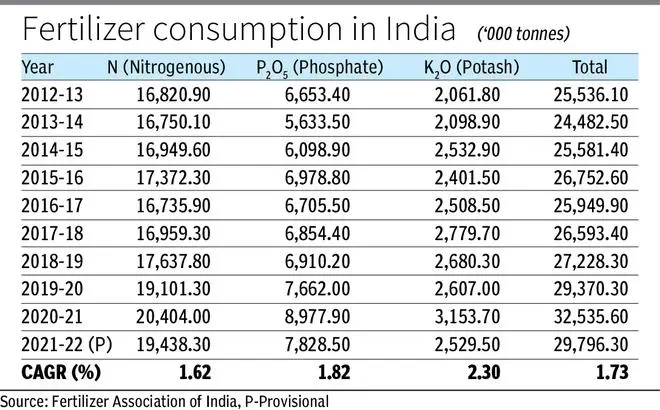Union Budget 2023–24 launched the PM-PRANAM (PM Programme for Restoration, Awareness, Nourishment and Amelioration of Mother Earth) to promote the balanced use of chemical and alternative fertilisers, generating awareness of regenerative agriculture (RA).
RA is an outcome-based food production system that nurtures and restores soil health, protects the climate and water resources and biodiversity, and enhances farms’ productivity and profitability.
Will PRANAM reduce the fertiliser subsidies and boost the RA? Can alternative fertilisers maintain higher productivity and ecological safety?
It is worth noting that the subsidy burden on chemical fertilisers is about ₹2.25-lakh crore for FY 2022-23, which is 39 per cent higher than FY 2021-22’s figure (₹1.62-lakh crore).
While the PRANAM scheme has no separate budget, a 50 per cent subsidy savings will be provided to States/UTs. Most of it will likely be used for infrastructure creation and (green) technology innovation. The rest will be paid as incentives to farmers, panchayats, FPOs, and SHGs who can help reduce input costs and generate awareness toward RA adoption.
Pluses and minuses
The PRANAM scheme may encounter a few challenges amid some opportunities.

Fertiliser consumption (see Table) shows that nitrogenous fertiliser consumption, especially urea, has not declined from 2012-13 until 2021-22 (P). However, the subsidy bill has increased significantly.
So, promoting PRANAM will help the government reduce subsidy bills and fiscal deficits if it picks up. Nevertheless, the efficacy of alternative fertilisers to enhance crop yield or productivity remains a concern. Thus, a gradual phase-out of subsidies on chemical fertilisers can stimulate alternative or bio-fertiliser adoption. The retention pricing scheme, which safeguards chemical fertiliser (urea) manufacturers, can be phased out to promote alternative fertiliser production. A 12 per cent return on the fertiliser (chemical) firms fixed under the retention scheme will disappear, possibly resulting in a knee-jerk reaction of chemical fertiliser firms for their survival.
On the contrary, farmer fertiliser cooperatives can exploit this as an opportunity since they have been into bio-fertiliser production, although on a small scale, since 2009-10. PRANAM can increase its economies of scale and help the extant distribution network stock alternative fertilisers. However, the margin on bio-fertiliser sales should be worked out to incentivise sales and distribution networks.
Demonstrating alternative fertilisers on farmer fields is critical, especially after the Sri Lankan food crisis, to showcase higher productivity, and certification of such products can help farmers or their organisations realise a remunerative price.
To this end, Finance Minister Nirmala Sitharaman, in Budget 2023-24, said that 10,000 Bio-Input Resource Centres will be set up over the next three years, creating a national-level distributed micro-fertiliser and pesticide manufacturing network.
Dey teaches at IIM Lucknow, and Basu is the Senior Vice President of Virenxia. Views are personal




Comments
Comments have to be in English, and in full sentences. They cannot be abusive or personal. Please abide by our community guidelines for posting your comments.
We have migrated to a new commenting platform. If you are already a registered user of TheHindu Businessline and logged in, you may continue to engage with our articles. If you do not have an account please register and login to post comments. Users can access their older comments by logging into their accounts on Vuukle.